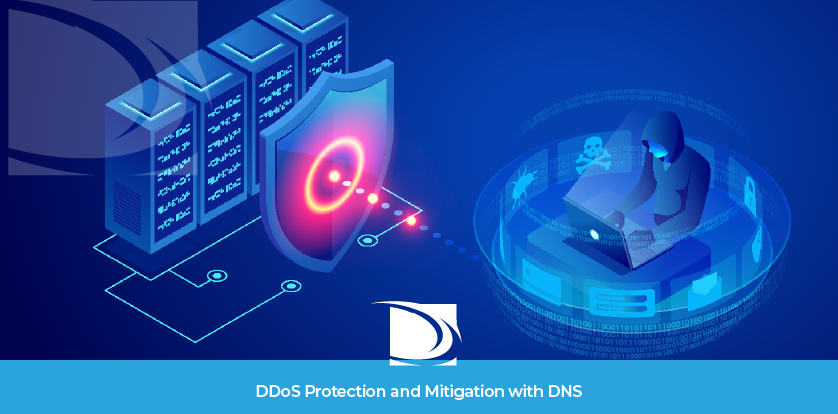
One of the greatest cyber threats organizations face today is the dreaded DDoS attack. In just the first quarter of 2020, there was a 278% spike in DDoS attacks and another 31% increase on top of that in the first quarter of 2021. With no signs of slowing down, it’s imperative that businesses keep DDoS mitigation at the forefront of their DNS and Cloud strategies.
DDoS Attacks Explained
DDoS stands for distributed denial-of-service. As the name implies, this type of cyber attack is designed to deny access to a domain. This is achieved by assembling a botnet (typically a large group of hacked devices) and instructing it to swarm a specific server or network. Websites and systems without redundancy are especially vulnerable to DDoS attacks as they can easily and quickly be rendered inoperable.
Tip: Want to learn more about this type of attack? See our “What is a DDoS attack” resource.
Why DDoS Protection and Mitigation Is Important
One minute of downtime can cost an organization as much as $5,600—sometimes more depending on the size and nature of a business. If you consider that the average length of an attack is around four hours, the cost could easily surpass the million-dollar mark. And that’s just from the duration of the attack itself. That amount increases when you factor in the staff hours it takes to restore systems to working order, loss of employee productivity, and less tangible points of consideration like damage to brand reputation.
To make matters worse, industry experts predict that DDoS attacks will begin lasting even longer—up to as many as 10 days. An attack of this duration could have lasting negative effects on any company. Threats like these can’t be ignored in our current digitized world.
Did you know?: The cost of downtime can be much higher for some corporations. For example, in the last quarter of 2020, Apple and Amazon reported record-breaking revenues that averaged $950,000 per minute. Just an hour of downtime for a company generating this amount of income would cost more than $57,000,000.
Failover For Added Redundancy and Protection From DDoS Attacks
Failover is a DNS strategy that is essentially a safety net for your domain. The way this service works is by configuring multiple IP addresses or hosts for your domain. When Failover is enabled, IPs/hosts are continually monitored by health checks. If a server or system is down, your web traffic will automatically be routed to the next healthy server in your configuration. DNS Made Easy and its sister company Constellix take it one step further and verify the health of your backup servers before sending traffic to another resource.
Failover is an effective and dependable way to avoid service disruptions. However, if you rely on only one DNS or CDN provider and they are a target of a DDoS attack or experience another issue that results in an outage, your domain will still go dark for as long as the provider’s outage persists.

Secondary DNS and DDoS Attacks
Secondary DNS is another safety precaution for your domain. Unlike Failover, Secondary DNS ensures your website or applications stay online even if your primary provider goes down. DNS Made Easy supports traditional Secondary DNS, while Constellix supports primary/primary configurations with API calls through services like OctoDNS and Terraform. These types of configurations are best practice since they afford you two authoritative nameservers for your domain. While not impossible, it is highly unlikely that two DNS or Cloud providers will experience an outage or attack at the exact same time.
How DNS Monitoring Tools Can Help With DDoS Prevention
With the right DNS monitoring tools, IT administrators can often spot anomalies or malicious traffic behavior before it has a chance to cause damage to a server or network. At DNS Made Easy, you have the option of using Real-time Traffic Anomaly Detection and advanced analytics alongside your DNS services.
The ability to monitor your domain’s web activity is critical for DDoS prevention and mitigation. With solutions like Real-Time Traffic Anomaly Detection, you can see unusual traffic patterns as they occur. This lets you make proactive decisions rather than reactive ones, as there is usually a noticeable spike in traffic at the onset of a DDoS attack.
When choosing a DNS or Cloud provider or if you want to bolster your current DDoS mitigation strategy, be sure to ask about any DNS analytics and reporting features. Such tools are invaluable in preventing DDoS attacks as well as pinpointing misconfiguration errors that can also cause large query surges.
DDoS Protection and Prevention is Possible With DNS
Having redundancy at every point of failure is the most effective way of preventing a DDoS attack. Fortunately, this can be done on the DNS level with the right strategy in place. While stand-alone DDoS mitigation services are available, having all your bases covered by redundant DNS or multi-CDN is the most cost-effective solution. And, if you select a provider(s) that has advanced analytics and/or monitoring tools, your domain can not only remain online during a DDoS attack, but can prevent an attack altogether.
If you liked this, you might find these helpful:
If you found this useful, why not share it? If there’s a topic you’d like to know more about, reach out and let me know. I’d love to hear your thoughts!







